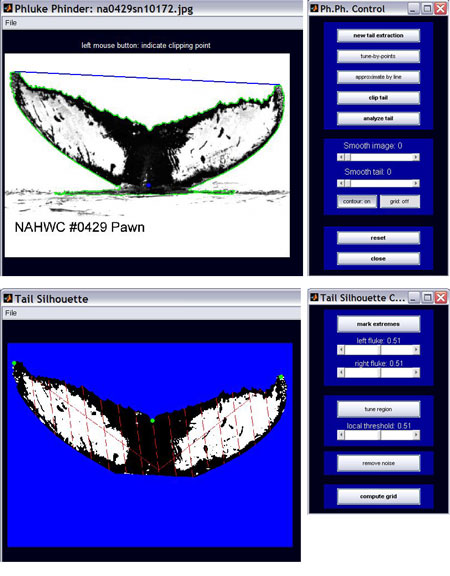
This issue in pdf Subscription Archive: Next issue: October 2005 |
|
||||
Computer Recognizes Whale Tailsby Annette Kik, Eric Pauwels and Elena Ranguelova How many whales are there in the ocean and how do they migrate? To answer these questions it is important to identify individual animals. Until now, biologists have tried to search by hand through vast numbers of photographs. In the European EUROPHLUKES project that ended in 2004, CWI researchers developed a method for semi-automatic pattern recognition of whale tails and dorsal fins. This is a first step towards the automatic photo-identification of individual animals. Governments and organizations such as the International Whaling Commission want to know more about whale populations in order to protect biodiversity and to make informed choices about possible hunting within certain limits. Using parameters such as the number and age of female animals, scientists can estimate mathematically how the population will evolve. Identification is an important tool in collecting these data for stock management. One of the most convenient ways is photo-identification. It is less intrusive than harpooning whales for a sample of DNA, and is more extensive because of the potentially large collections of photographs from biologists, sailors and tourists.
The EUROPHLUKES project commenced in 2001. Its brief was to develop a photo-ID system and database for cetaceans - whales, dolphins and porpoises. The objective was to be able to identify if a particular cetacean had already been photographed, and if so, where and when. The network comprises more than forty partners and participants, mostly marine biologists. It is coordinated by the Universiteit Leiden and is funded by the Fifth Framework of the European Union. To deal with specific computer vision problems, researchers from CWI’s Signals and Images group, a member of ERCIM’s WG on Image and Video Understanding, were invited to the team. Watershed Method To recognize individual characteristics semi-automatically, CWI researchers combined and applied several mathematical techniques: image segmentation, contour and feature extraction and finally, comparison of these data with an image database. First, the grey-level of the image is represented as a three-dimensional picture: white is high, darker is lower. At the edge between sea and tail the difference in grey-scale will be large, or in other words, the gradient will be high. The picture of this gradient can be viewed as a ‘topological surface’: It has mountains, plains and valleys. In the so-called watershed method, virtual water floods this surface. When the water is so high that two lakes in valleys are about to merge, a virtual watershed is placed. This procedure has been programmed in MATLAB, a technical computing language, allowing the computer to robustly identify regions of similar grey scales and thus extract the contours of the tail or dorsal fin. Spots and Scars The performance can be improved by combining the above feature vector with a more detailed mathematical description of specific, salient spots and scars on the animal. With morphological processing these marks can be found - both their centre of gravity with respect to the grid and a computed approximating ellipse. Using these data, the computer gives a top list of potential matches with pictures from the database. The user can then pick the actual match from this shortlist or confirm that there is no matching animal in the database. This method makes it possible to compare pictures with larger cetacean databases. Links: Please contact: |
||||


